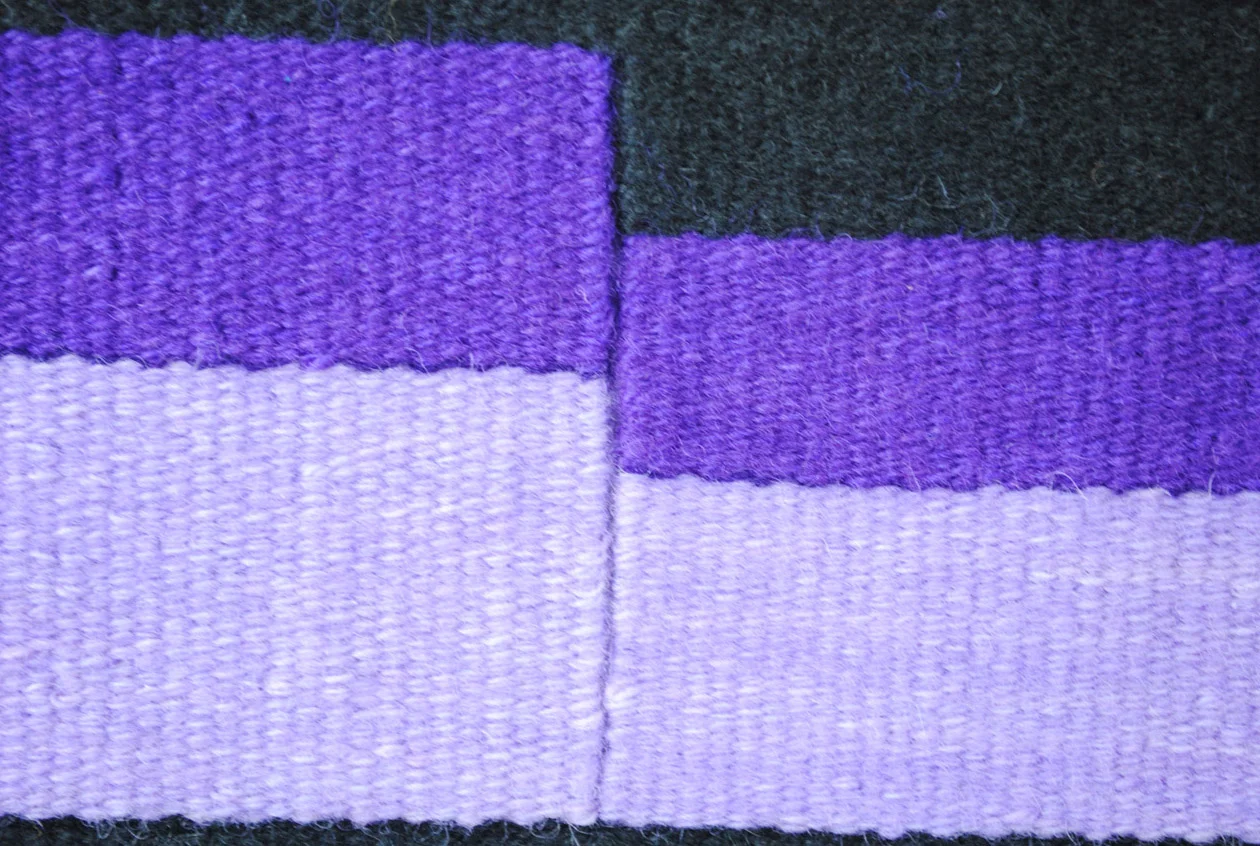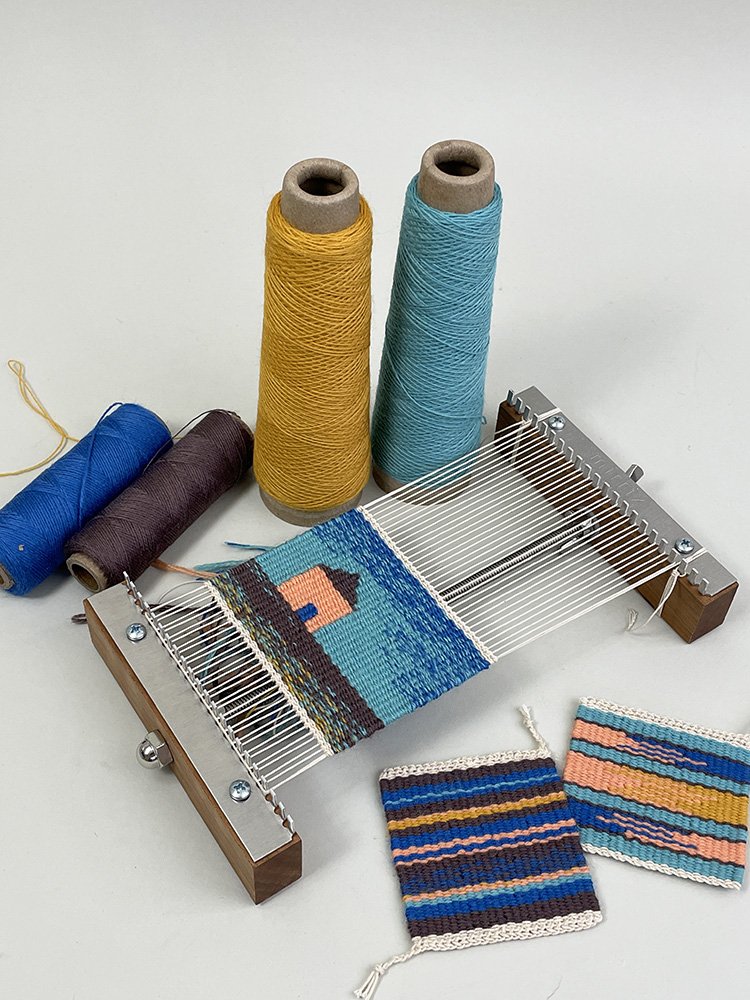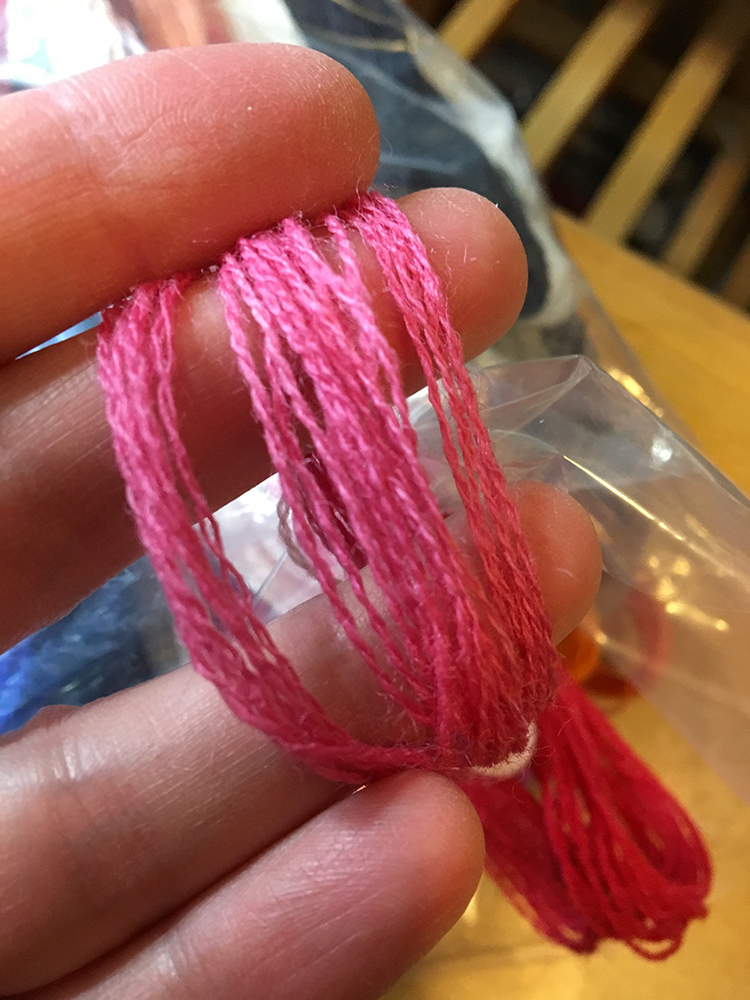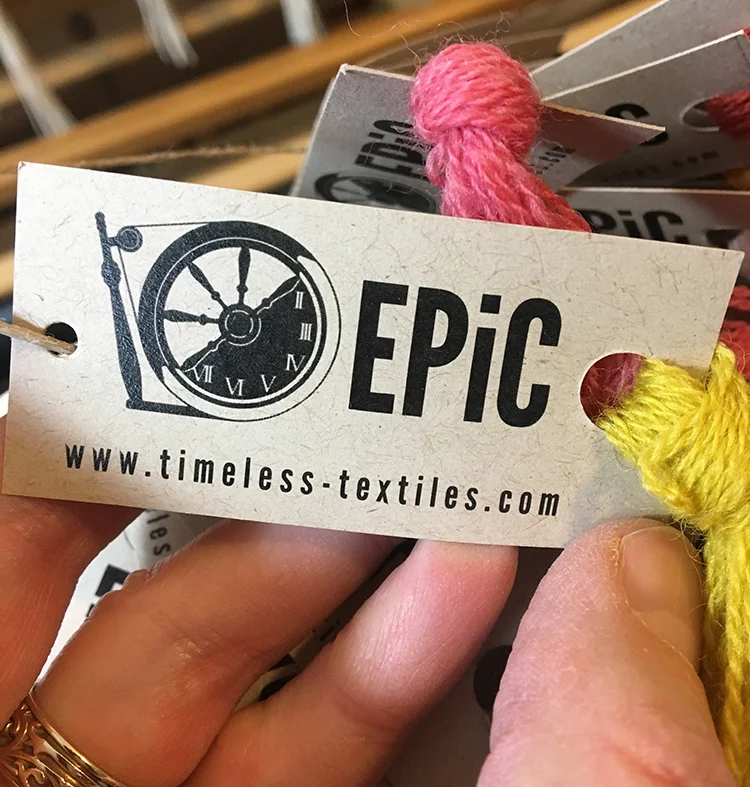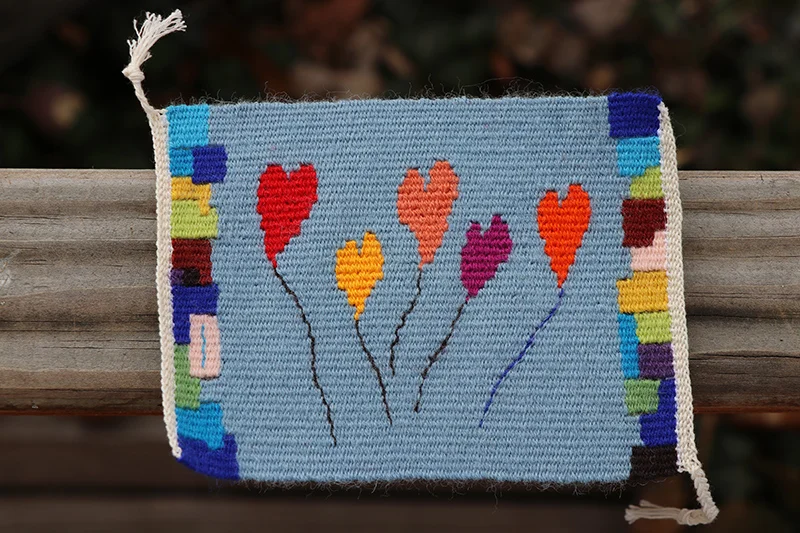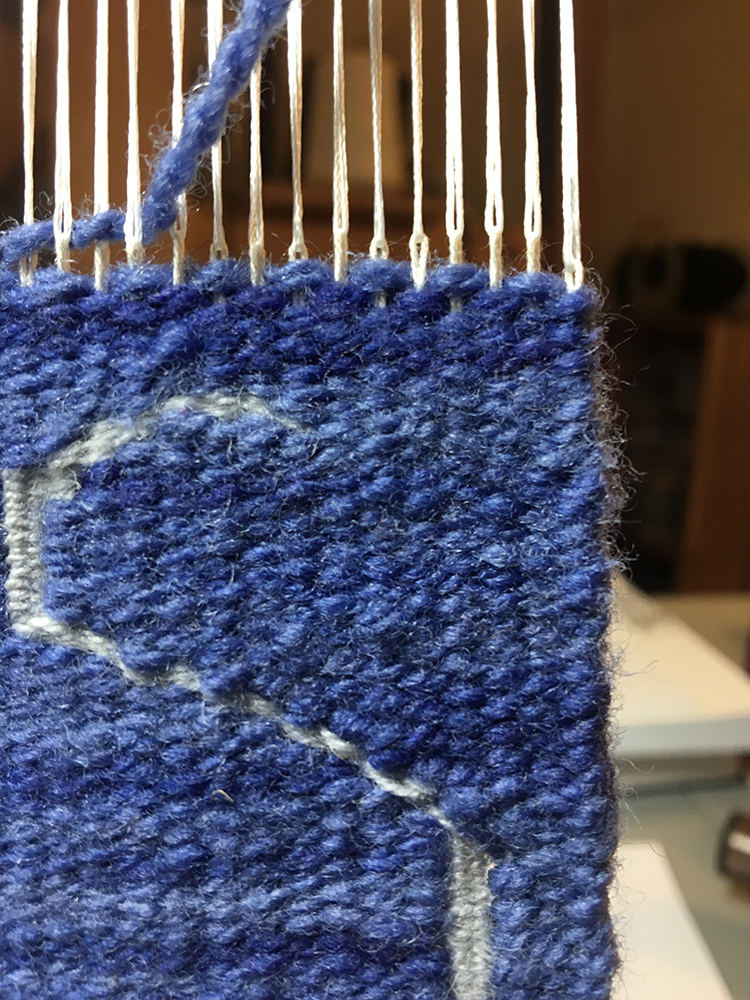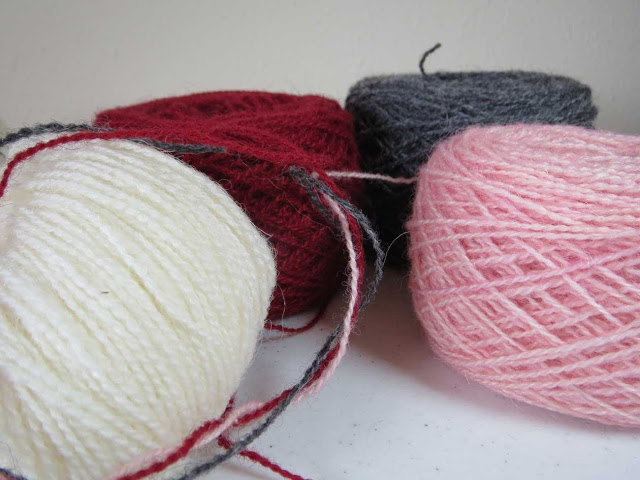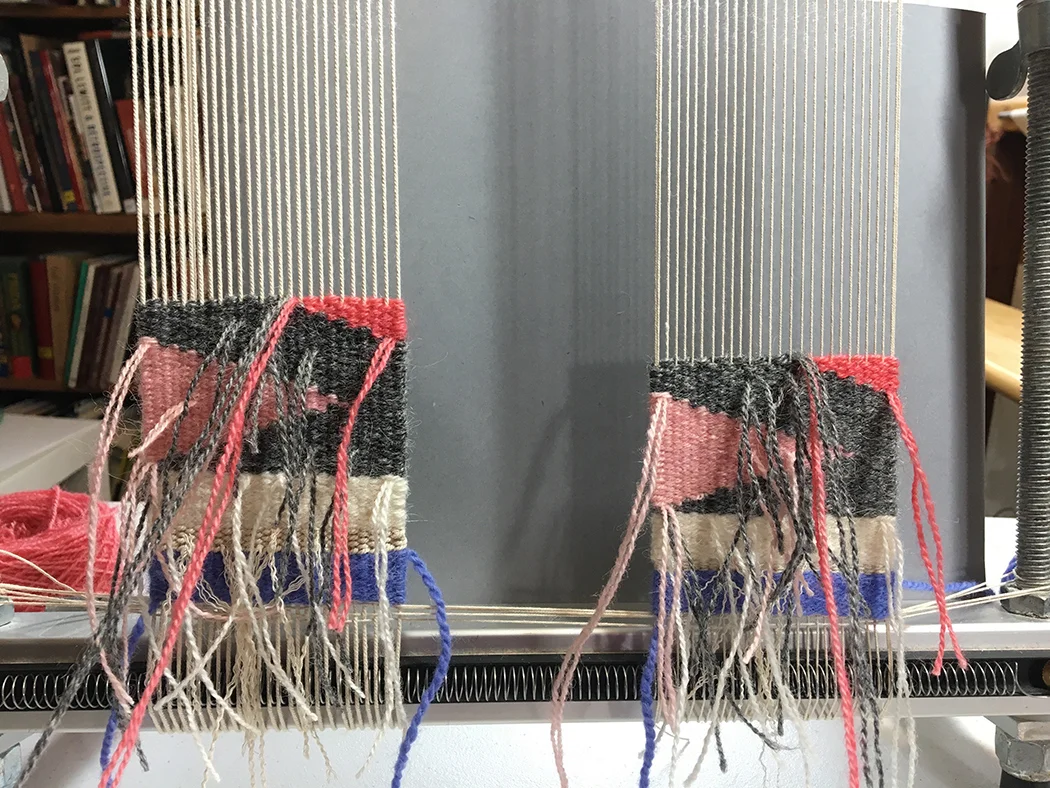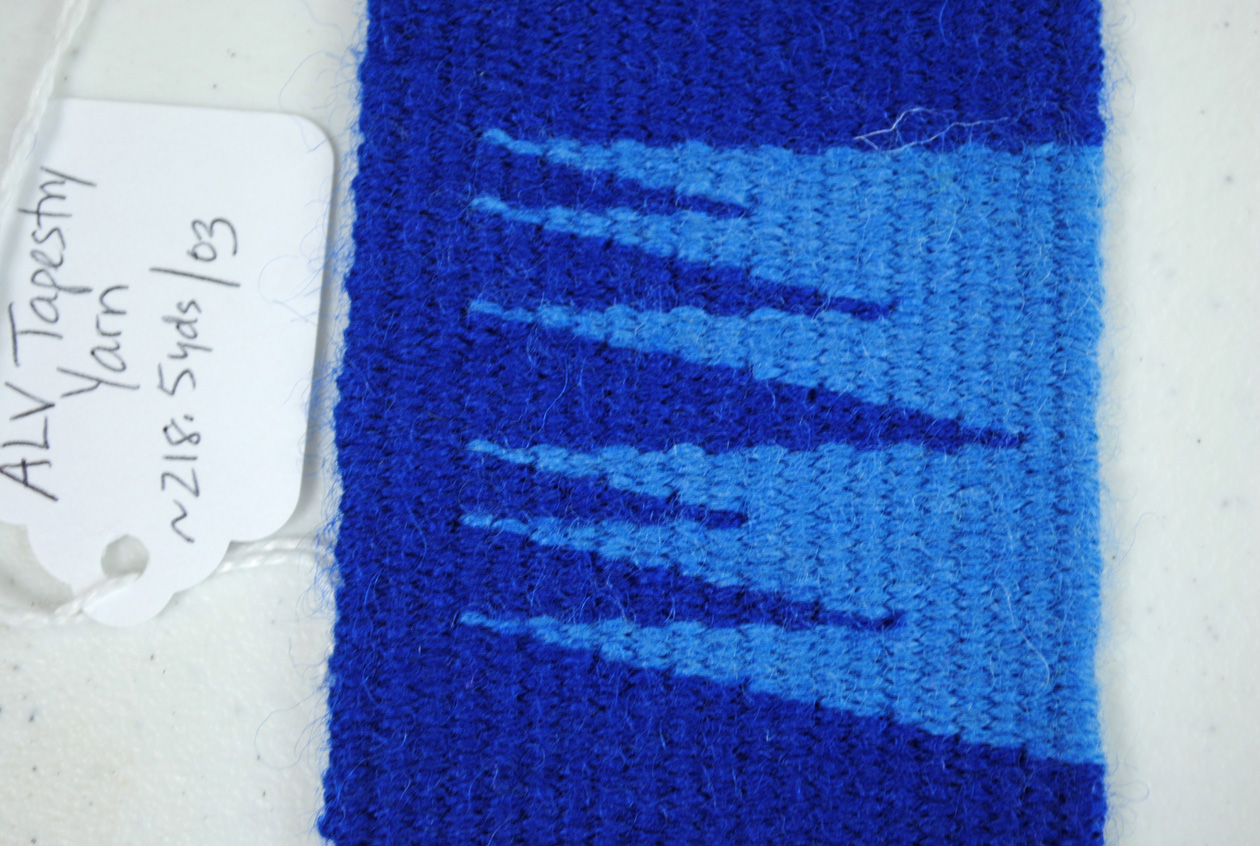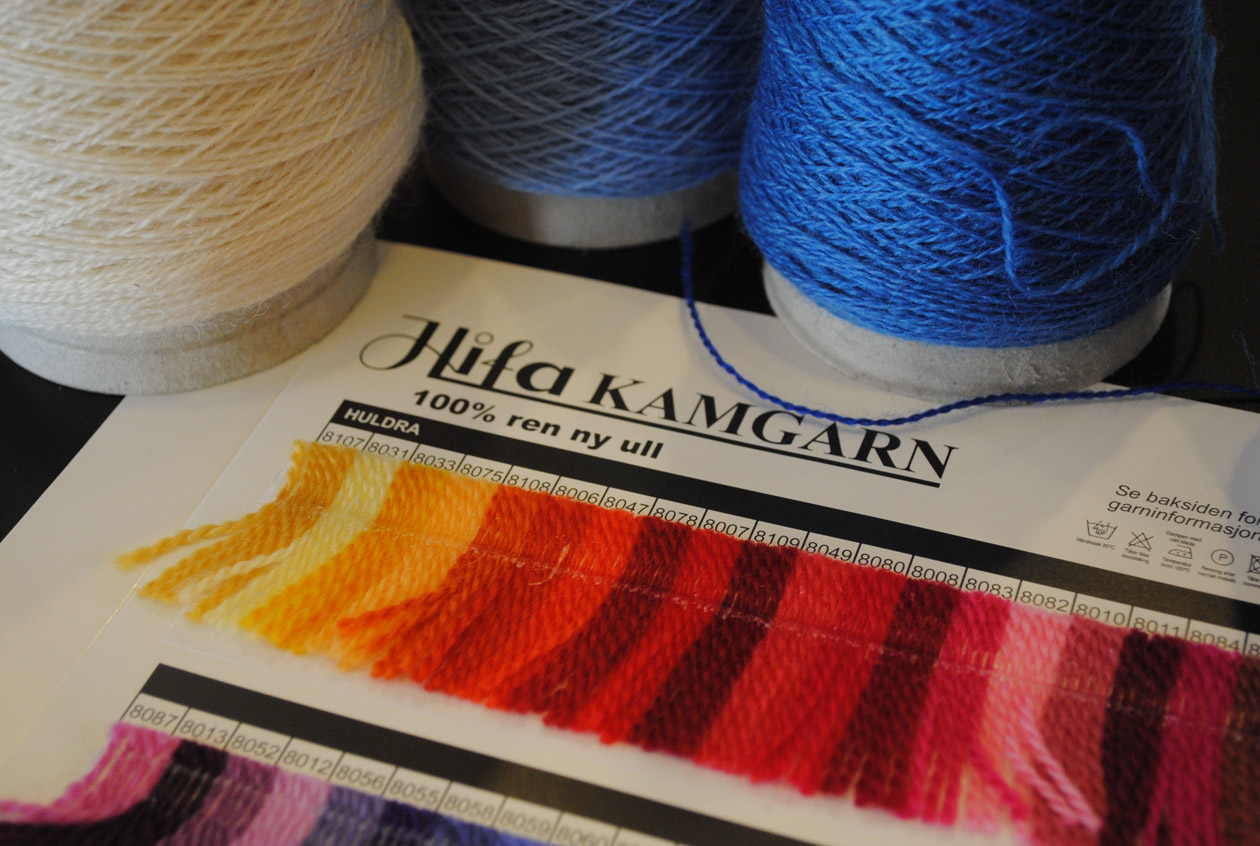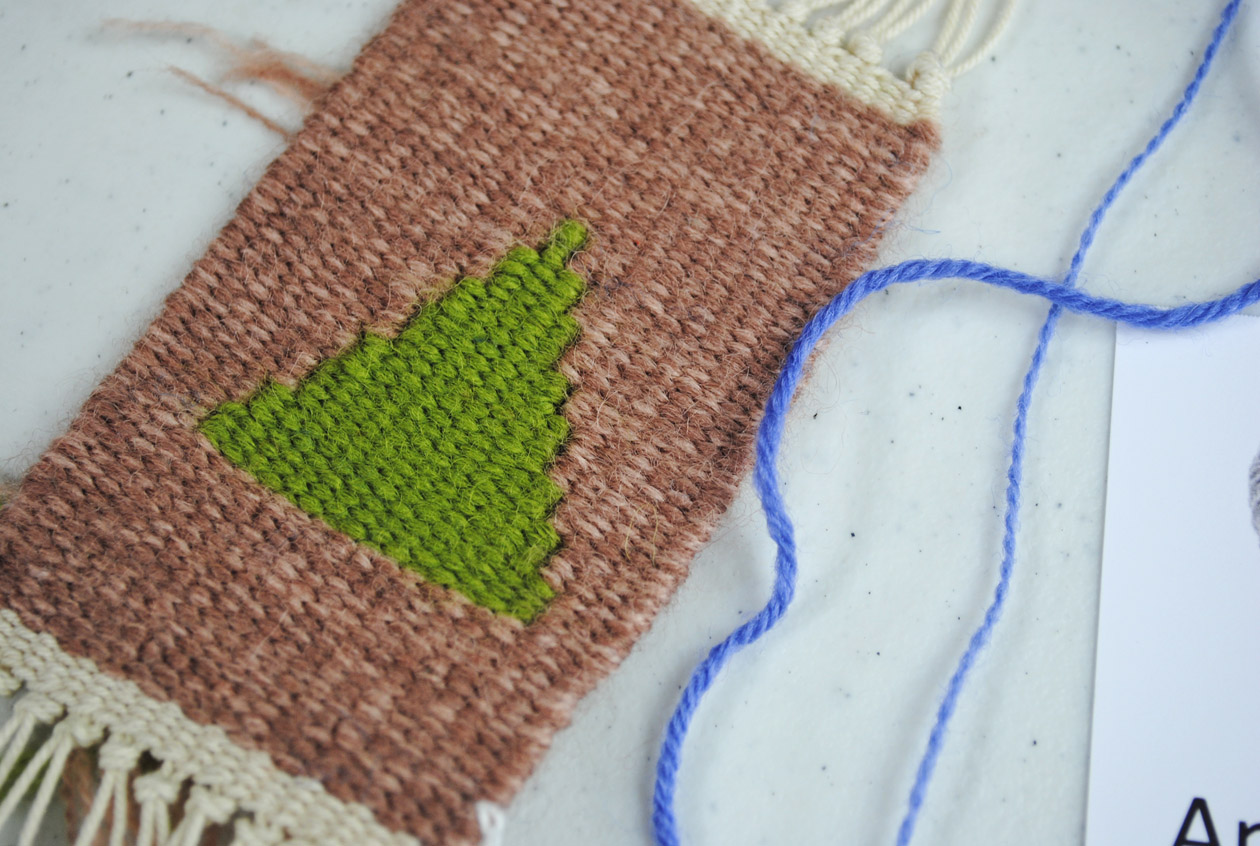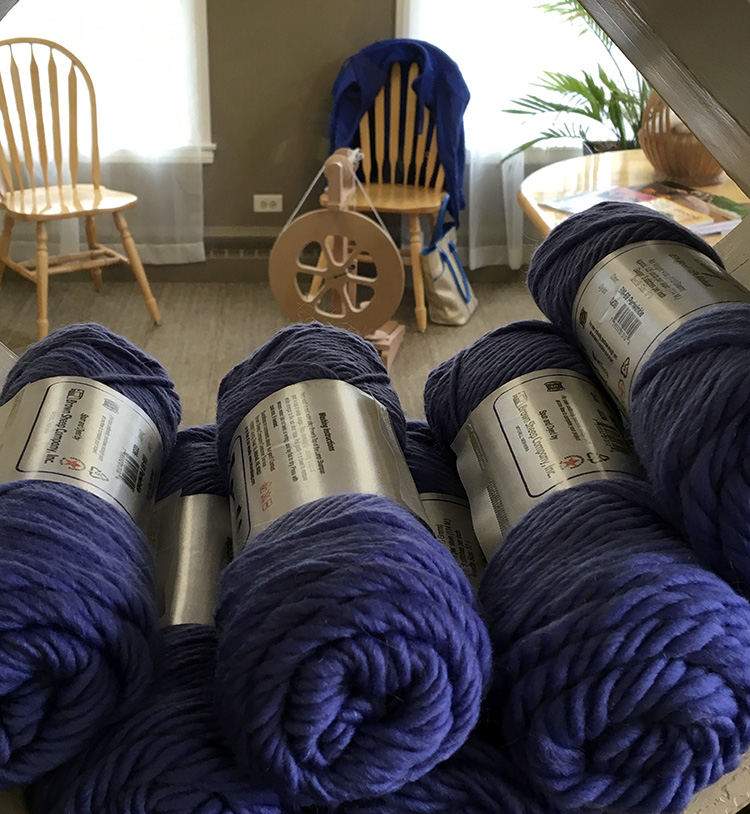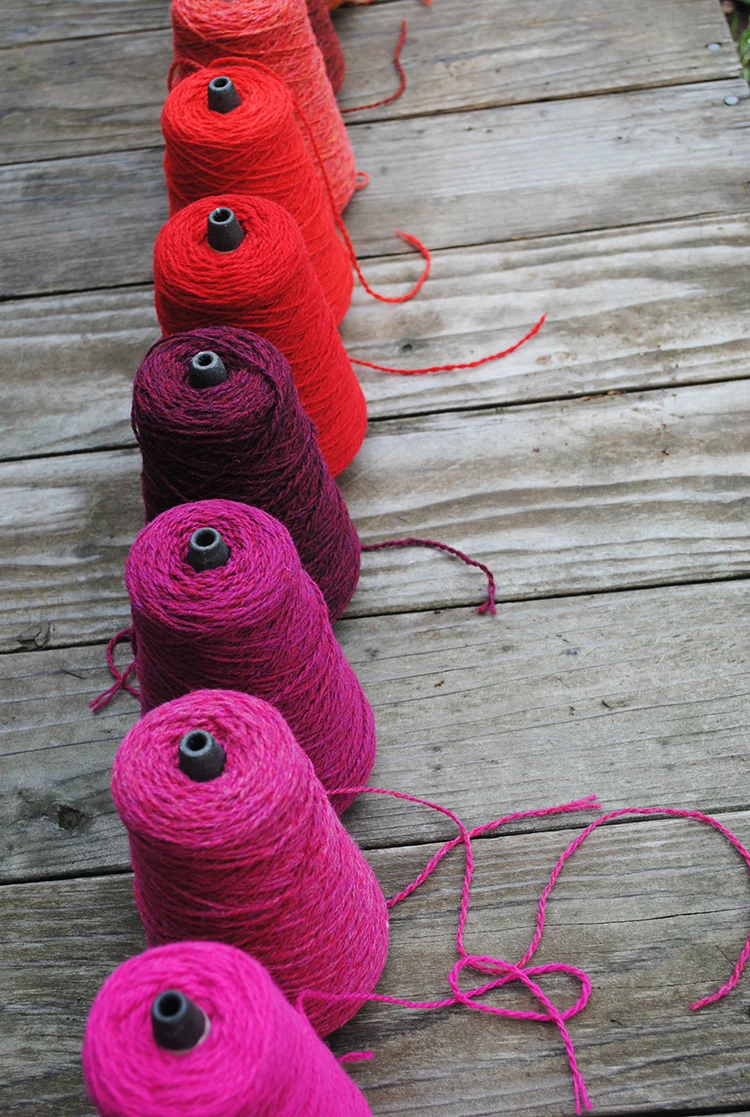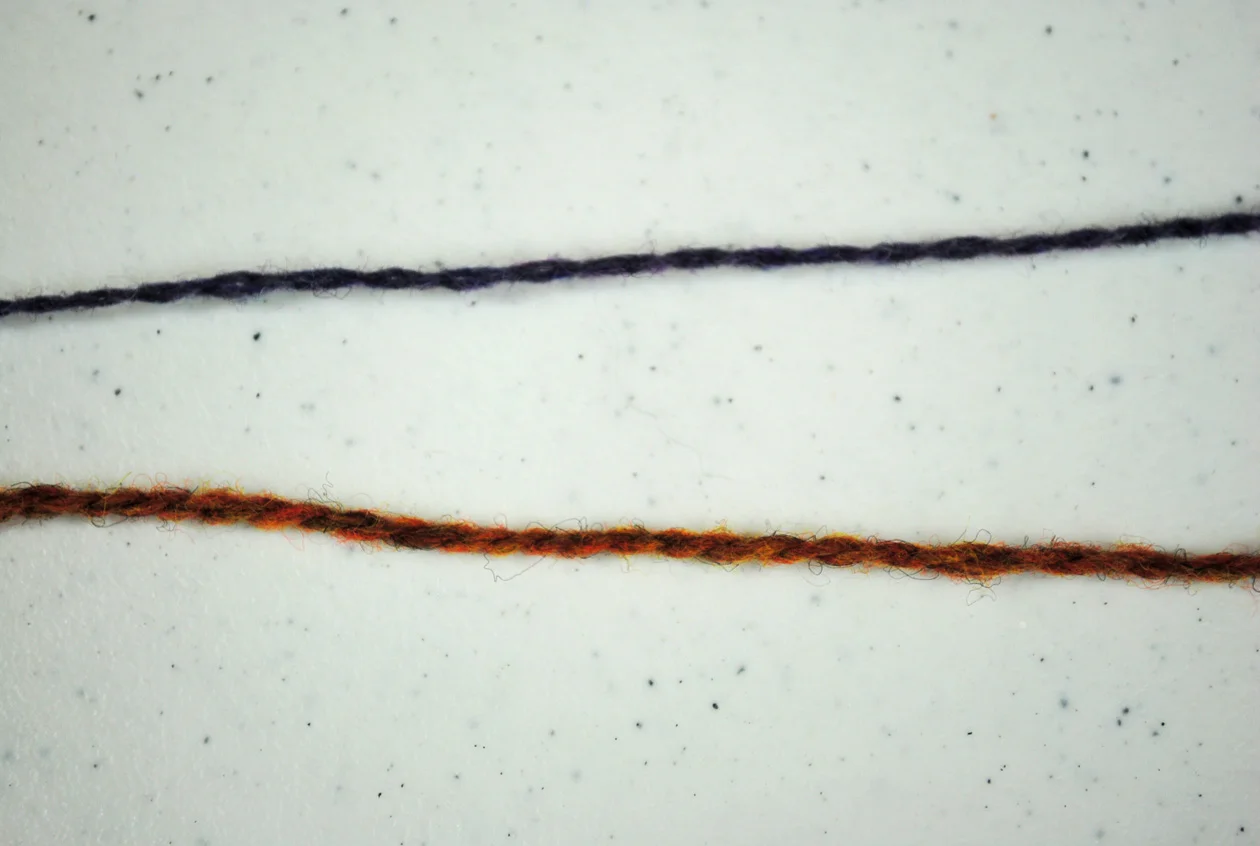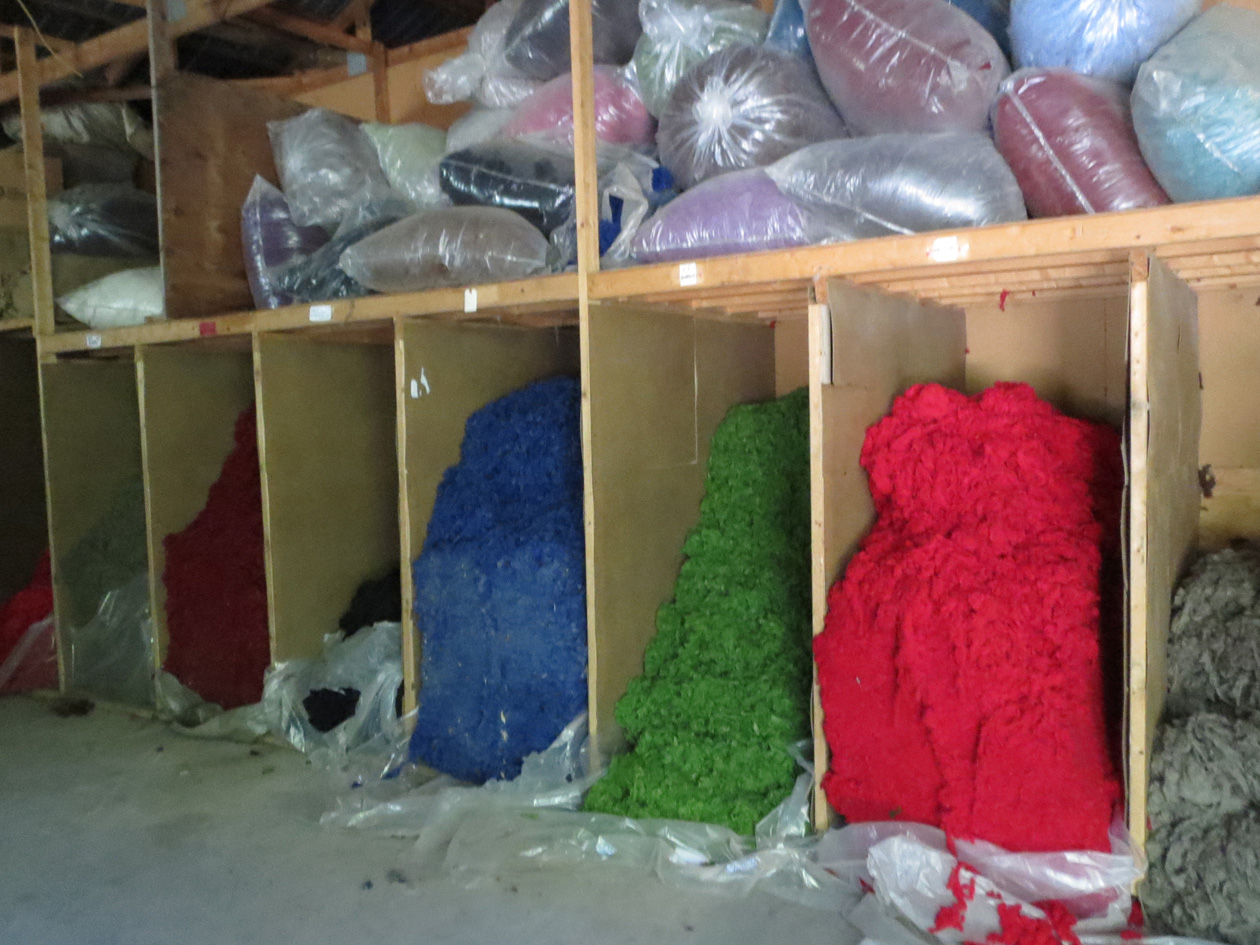(Updated 8-1-23: I also have an online course about choosing tapestry yarns: What Makes a Good Tapestry Yarn?)
If you’re a tapestry weaver, finding just the right yarn might seem like a difficult proposition. Through my students and my own testing of various yarns, I’ve found a few sweet spots in tapestry yarns over the years and I hope these ideas are helpful for you, dear tapestry friend. I’ll briefly tell you what makes a good tapestry yarn and then I’ll tell you which ones are my current favorites and where to get them.
If you’re just starting out, it is helpful to pick one yarn and sett to learn on. I always recommend starting with one weft yarn. Learning tapestry is tricky enough without having to learn to manage the way different yarns behave. A teacher can help you with this information but this post should help get you started. Notice as you use that yarn at the sett recommended, what you think about it. How does the yarn serve your design ideas? Does it come in colors you like? Is it easy to work with? I have a few possible combinations at the end of this post, but there are many other possibilities. I also cover this topic in my online course, Warp and Weft: Learning the Structure of Tapestry as well as a short focused course, What Makes a Good Tapestry Yarn?)
What makes a good tapestry yarn?
Not all yarns are good for tapestry weaving. In fact, most yarns you’ll find in your local yarn store (if you’re lucky enough to have one), probably aren’t the best for tapestry weaving. It can be a little overwhelming to choose yarns for weft. Let’s look at which characteristics are important in a tapestry yarn, why they are important, and which yarns have these characteristics. I’ll also let you know which yarns have the widest array of color choices.
This is by no means a comprehensive yarn list. There are wonderful tapestry yarns all over the world that I know nothing about, so if you know of one, please leave it in the comments.
Here are some things to look for in yarns used for tapestry weaving.
Rebecca Mezoff, Lifelines in process
A firm yarn that is not lofty. Lofty yarns pack in too much which means you have to weave many more picks to fill in your forms. They have a lot of air in them which makes them lovely for knitted garments but terrible for weft-faced weaving. You want a firm yarn that will pack easily and make a sturdy fabric. Remember that tapestry will most likely be hung on a wall and you don’t want all your squishy yarn compacting over time and sinking on the warp.
A yarn that doesn't have a whole lot of end-to-end stretch in it. When a yarn wants to bounce back on itself (as a nice knitting wool will do), it will want to do that in your weaving which causes problems with weft tension and makes your edges draw in.
Color choice. If you're not a dyer, color choice is going to be very important to you. Many commercially dyed yarns don't come in that many colors. If you are weaving something for which you want 5 reds in gradation, most commercial yarn sources are not going to provide that (with the notable exceptions of weaversbazaar, Australian Tapestry Workshop Yarn, Appleton crewel, Colonial Persian, and Gist Yarn’s Array).
Thin yarns you can use multiples of in a weft bundle versus a thick yarn you'd only use one strand of. Using a yarn that is very thin that you can bundle in the weaving gives you more color options. You can bundle singles (yarn that is not plied or consists of only one twisted piece of fiber) or plied yarns (yarns that have two or more bits of fiber twisted together in a consistent way) if they are thin enough to use more than one together. If you are new to tapestry and want to use just one strand of yarn at a time, you're going to have to look for a fatter yarn that matches the warp sett you want to use.
So why are these characteristics important in a tapestry yarn?
Tapestry is a weft-faced weave. The warp is set widely enough that the weft slides down over it to cover it completely. The weft needs to be firm enough that it can maintain the structure of the textile. If the weft is super bouncy, fluffy, or soft, it will pack in excessively. Bouncy yarns also stretch a lot and that makes managing your weft tension difficult. Color choice is important and if you are a dyer, you have the advantage of being able to make whatever color yarn you want.
I think it is important to buy a small amount of a new yarn and try it out in a sample or a small piece before you invest a lot in it. Not every tapestry yarn listed here will be liked by every weaver. Some yarns are very shiny and reflective. Some are duller and fuzzier. Some easily create a very flat surface depending on the warp size you use, others will show every weft relay pretty clearly.
What are some good tapestry yarn choices?
Yarns to use one strand of at a time
If you’re a beginning tapestry weaver, you like to weave very graphic designs, or you’re weaving rugs, you want a yarn that is big enough to use just one strand at a time.
Harrisville Highland
Balls of hand-dyed Harrisville Highland for tapestry weaving
This is the yarn I use for my in-person workshops for students. It is made by Harrisville Designs, a wonderful small mill in Harrisville, NH. In my early tapestries, this was the yarn I used, though I dyed it myself. The yarn is dyed in the fleece which means that they get huge bales of dyed fleece and then mix the fleece colors when the yarn is made. The undyed version makes a beautiful, consistent yarn. Harrisville makes the yarn in 64 colors. Most of them have a very heathered appearance because of the way the colors are mixed. This means that the yarns blend well visually because a color might have bits of red and blue in it to make a violet. I will note that a lot of the values for this yarn are in the middle of the grayscale range and this can mean a muddy-looking composition if you don’t consciously try to add some lighter or darker values. It is 900 yards per pound and if you buy it on the cone for tapestry weaving, you will need to scour it first as the coned yarn still has machine oil in it from the manufacturing process. That is a simple process and I will have a video about it soon on my YouTube channel. (The Weaver’s Loft is selling this yarn in 1 ounce balls in a couple different color palettes.) If you purchase Harrisville Highland in skeins, it has been scoured.
Lamb’s Pride Worsted
This yarn is made by Brown Sheep Company, a marvelous small mill in western Nebraska. Lamb’s Pride is a fat single and it has mohair in it. This means that it is rather shiny and a fun thing to try for tapestry weaving. One strand of the worsted weight works well at 8 epi. Because it is a fat single (it isn't plied), it creates a strong diagonal effect when woven in weft-faced tapestry. This yarn is available in many places and might be the easiest yarn to lay your hands on in your LYS, which is exactly why I’ve included it on this list.
Crown Colony
This is a Canadian yarn that I have only been able to find in white. If you’re a dyer, this is a great option!
Quebecoise
This is another Canadian yarn that you can get in the USA HERE. This yarn is quite similar to Crown Colony but you can get it dyed.
Thinner yarns that can be bundled
Of course there are various sizes of yarns for tapestry. If you like to bundle yarns for maximum ability to mix colors, you’ll want a thinner singles yarn. Here are a few options for singles listed generally from thickest to thinnest.
Frid Vevgarn
This yarn is sold in the USA by Norsk Fjord Fibers. It is a beautiful yarn that has some spelsau in it (sheep breed) that makes it very shiny. It is not at all soft. It is made in Norway and is a 2-ply yarn which is slightly thicker than the Harrisville Shetland. You can use a couple strands together at 8 epi (I've heard of people using as many as 4 together at this sett depending on your warp and your tolerance for lice). This yarn dyes very nicely, comes in 108 colors, and comes from Hiilesvåg Ullvarefabrikk, a spinnery on the west coast of Norway. It is available for sale in Europe as well.
Harrisville Shetland
This yarn is half the size of Highland. I use one strand at 12 epi or two strands at 8 epi. The surface of the tapestry is not as smooth when you double the yarn than if you use one strand of Highland or if you split the Highland strands and reply two colors together if you’re into color mixing. It comes in the same 64 colors that Highland does.
Paternayan/Colonial persian
Paternayan used to be a favorite of tapestry weavers because it came in so many colors. The company went bankrupt after being sold to a new owner and the original dyer of the yarn has teamed up with Colonial Needle to sell it again. It is now called Persian Yarn and the maker is Colonial Needle. You’ll want to check needlework stores to purchase.
Gist Yarn’s Array
As of the fall of 2021, Gist Yarn is offering this Made-in-the-USA tapestry yarn that comes in gradations and was designed especially for tapestry weavers. It is a beautiful yarn that comes in value gradations. I use this yarn a lot on Change the Shed and for some of my own work and there is a bundle available from Gist that includes my Introduction to Tapestry Weaving course, a Mirrix Saffron loom, a cone of seine twine warp, and their weft yarn.
As of 2023, Gist Yarn and I are collaborating on the Tapestry Discovery Box. This is a subscription product where you get 7 colors of Array every quarter (4 times a year) along with course content from me where we explore a technique and weave a project using those colors.
Harrisville Designs Koehler Singles
The yarn I use for my many of my large-format tapestries is made by Harrisville Designs. It is the Harrisville Koehler Singles, but it is only available in white. If you’re a dyer, this is a fantastic choice. The yarn is 2,700 yards per pound and it works well at 3-4 strands at 8 epi.
Faro
If you don’t dye your own yarn, Faro is a yarn that is similar in size to the Harrisville Koehler singles. It is made by Borgs in Sweden. It has a little more shine than the Harrisville due to the kind of fleece used. This yarn works well with 3-4 strands at 8 epi. It is a singles yarn meaning that it is not plied. It dyes beautifully and comes in 74 colors. You can find it through many dealers in the USA. Note as of 2023: Borgs has closed after something like 300 years of production. There is a new Swedish company making this yarn and I anticipate it will continue to be available around the world.
Additional Bockens yarns: Though I have mostly only used Faro, this company also makes other yarns that are great for tapestry. Those include Tuna, Mobelatta, Mattgarn, and Mora. They are available from GlimakraUSA or Lone Star Loom Room.
Weavers Bazaar
Rebecca Mezoff, Bootsy. This tapestry was woven at 12 epi with two strands of Weavers Bazaar 18/2 fine wool.
This has become one of my favorite yarns for small format tapestries. Weavers Bazaar is a company in the UK run by tapestry weavers. They are doing a fantastic job serving the tapestry community all over the world and we should support their efforts. Fortunately, their product is fantastic and well worth purchasing. Their yarns come in three sizes. For bundling I love 18/2 fine and if the sett is wider, I’ll add a strand or two of the 9.5/2 medium sized yarn. The 9.5/2 is twice the size of the 18/2. I haven’t used the heavy yarn much, so if you do, let me know what you think! I use about 6 strands of the fine at 8 epi. I frequently use 2 strands of the fine at 12 epi for my very small tapestry diary pieces. The yarn comes in fantastic colors and they’re adding more all the time. You can get all sorts of gradations, so enjoy the options! I have dyed this yarn myself, but in general I just buy their colors because there are so many available.
ALV
A yarn from the same spinnery in Norway as Frid Vevgarn, Hiilesvåg Ullvarefabrikk, this is a much thinner yarn with a softer hand. It is sold by Kathe Todd-Hooker at Between & Etc. Kathe says she uses 4 strands at 10 epi. I have woven a little with this yarn and love the feel of it. Kathe sells this yarn by the ounce, so if you want to buy some small amounts to play with, that is an option.
EPiC
This yarn was unavailable for a few years after the company owner passed away. It was bought by Timeless Textiles and production is now up and running again. This yarn is made in Portugal but sold in the USA and can be purchased from their website. This is a thin yarn which will need to be bundled. It is similar in size to ALV and Appleton crewel. The interesting thing about this yarn is that many of the colors are intentionally dyed to give it that slightly variegated, hand-dyed look. This can be an attractive characteristic in tapestry. If you’re interested in it, they sell a couple sample packs with small amounts of all the colors.
Appleton crewel
This is another thin yarn that I like a lot. Don't be fooled into ordering the “Appleton Tapestry” yarn though. Both yarns are made for embroidery, but the crewel yarn is much thinner and firmer. The tapestry yarn ("tapestry" is often used in Europe to refer to embroidery) is fluffy and rather like a thicker version of Paternayan. The crewel yarn can be bundled for a very nice woven tapestry surface with color variations. This yarn comes in 400 colors and can be found in embroidery shops in the USA.
Some sad news about Weaving Southwest along with alternatives
Weaving Southwest yarns lined up behind this color wheel at the recent Taos retreat
Those of you who love hand-dyed yarn but don’t want to be dyers yourselves may well have been fans of the marvelous yarns created by Weaving Southwest. This wonderful place in Taos, NM was my first gallery when Rachel Brown was still alive. It was taken over by her granddaughter, Teresa Loveless, and for various reasons is closing in March of 2019.
I just want to pause a moment and help you think about the monumental thing it was to stock shelves in a shop and sell online yarn that was completely hand-dyed. I dye my own yarn and I sometimes dye for my workshops and I will tell you that the work is fiercely difficult labor. It was an incredible thing that Teresa and her family were able to dye this yarn themselves for so many decades and offer it to the general public. We will miss the 2-ply tapestry yarn and especially the churro.
Here are a few alternatives:
For churro, contact Shepherd’s Lamb in Tierra Amarilla, NM. They are producing hand-dyed churro yarns that are beautiful.
Taos Wools: Weaving Southwest’s own Joe Barry has started his own business hand-dyeing yarn and you can get some of his marvelous colors again. I recommend getting on his newsletter so you know when he is releasing more colors as they sell out fast. His hand-dyed wools are beautiful though they only come in single ply churro. The tapestry weight is thin enough that you can use a couple strands at once.
Mountain Meadows mill in Wyoming does some lovely hand-dyed yarns which are quite similar to the base yarn that Weaving Southwest was using for their 2-ply tapestry wool. Unfortunately it doesn’t yet come in many colors.
What if you’re allergic to wool or animal fibers?
There are many people who make beautiful tapestries from cellulose fibers. Look for cotton and silk fibers to start with. I have used pearl cotton, a common weaving cotton, for small tapestries with good results. Some small format weavers regularly use DMC floss and Kathe Todd-Hooker often uses regular sewing thread for her very fine works. Of course to use sewing thread you will be weaving at very close setts, so don’t try this if you’re brand new to tapestry weaving. You can also search out bamboo, linen, and even synthetic fiber mixes.
I have successfully used Cascade Ultra Pima Cotton which comes in solid and variegated colors. It worked well at 8 epi with one strand.
Ask around. Though I don’t have a wealth of knowledge on non-protein fiber tapestry yarns, there are people out there who use them and you should not let reactions to one fiber keep you from using others or from weaving!
What yarns would you not use for tapestry and why?
Though I recommend some embroidery yarns above, many embroidery yarns are not great for tapestry. Though I love the Brown Sheep Company for so many reasons, their embroidery yarn, Waverly, is very bouncy to be used for tapestry. I especially don’t recommend it for beginners.
I have had many people tell me they’ve used Jaggerspun yarns for tapestry. They are thin and come in many colors and are often used for weaving functional fabrics. I tried some of it while teaching at Penland a few years ago and I thought it was way too soft for tapestry especially in large-format. This is just my opinion and if you love it, weave on!
Knitting yarns. I wrote a whole post about knitting yarns for tapestry. Yes, I’ve tried it. It is a tough way to weave tapestry.
The gallery below has more photos of some of the yarns I’ve mentioned above. Click on thumbnails to enlarge, hover for captions, use arrows to scroll.
In March of 2021 I wrote a post about choosing weft yarns that you can find HERE. It includes a video and I talk about my anchor yarn concept from my book, The Art of Tapestry Weaving.
A few years ago Cheryl Riniker did a lovely guest post where she talks about her favorite tapestry yarns and shows the woven samples she did with each of them. It is worth a look HERE.
What are your favorite tapestry yarns and why? Do you like ones I haven’t mentioned here? Tell us in the comments!



